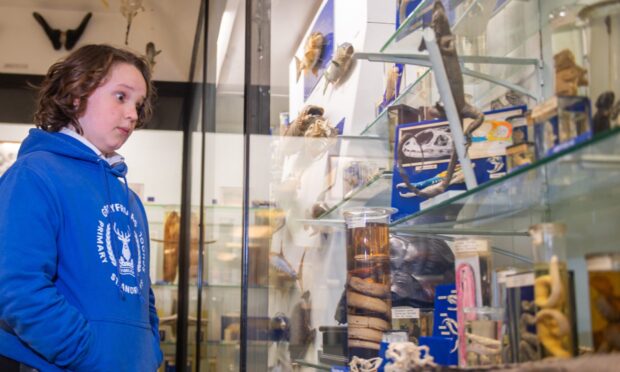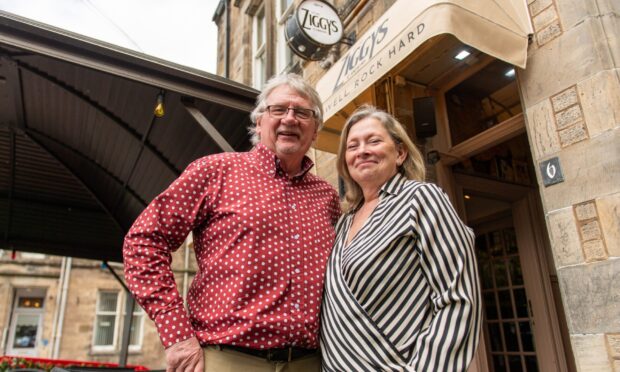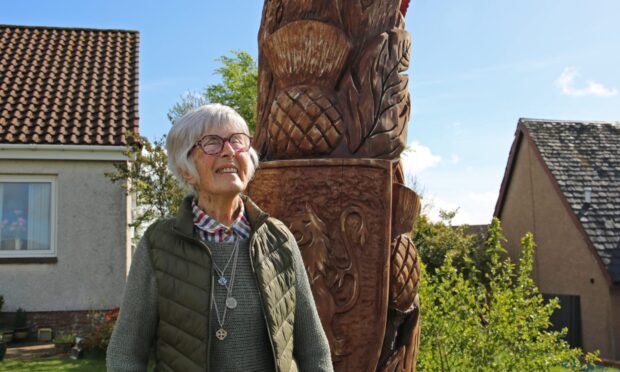There’s nothing like a secret location to pique the interest of a little person.
When the destination is hidden in plain sight in the centre of St Andrews the anticipation hits new levels.
My younger children’s tiny minds were blown when an ordinary door to one of the St Andrews University buildings opened.
One of the museums team popped out to welcome us to the mysterious attraction.
Once inside, we stepped over the floor mosaic proclaiming Bell Pettigrew Museum, the first physical clue to our destination.
From fossils to formaldehyde
The weirder the better when it comes to my kids. They were intrigued by the examples of all kinds of creatures which had been suspended in formaldehyde over 100 years ago.
Sea creatures, rodents, snakes and more hang in suspended, slightly unsettling animation.
We were lucky to visit on an afternoon when collection trainee and all-round Bell Pettigrew nerd Conall Treen was on hand to tell us a few tales about the museum.
The collections trainee has written an entire PhD thesis on the museum and is delighted to share his expertise with his young visitors.
History of the St Andrews museum
Originally established as a zoological teaching museum in 1911, the building was opened in 1913 and some items in the collection date back to the 1870s.
Unfortunately the galleried first floor was covered in the 1960s to provide more teaching space but all of the original cabinetry and cases on the ground floor remain.
One case even retains damage from shrapnel that fell during a bombing raid in WW2.
The museum staff agree that the exhibits are ‘of their time’. They do stress that although the displays don’t conform to modern ideals, they are still a vital tool in our understanding of the natural world.
Some of the specimens can hold important clues about climate change and biodiversity.
Favourite exhibits at Bell Pettigrew
I was interested to find out what the kids liked about the museum. Daughter number two proclaimed a model of a dodo her favourite and she was fascinated by a particularly macabre taxidermy of a spider eating a bird!
For her brother, the enormous skeleton of a spider crab grabbed his attention as soon as we entered the museum.
He loved the snake skeletons and the rather gruesome-looking tube containing a rat-snake.
We all enjoyed peering at the small but perfectly formed examples of coral – all carefully catalogued and displayed in a beautiful wooden case.
The same corner of the museum is home to a gorgeous example of a sea sponge called Venus’ flower basket.
Local links on display at Bell Pettigrew
Among the creatures and objects from far-flung corners of the world, there are some items that have links closer to home.
There is a reconstruction of the skeleton of the cart horse ‘Bassey’ who helped to build the Bell Rock Lighthouse.
Slabs of ancient sandstone from Fife’s Dura Den include incredibly detailed fossils of ancient fish.
View many now-extinct species
My wee girl’s favourite dodo aside, the museum includes other examples of now-extinct creatures.
The tiny St Kilda house mouse died out after the last 36 islanders were evacuated from the island in 1930.
You can also marvel at a giant skink (a vegetable-eating lizard) or a Tasmanian Wolf.
Kids will also love spotting a couple of examples of ‘terrible taxidermy’. One is a kiwi in an unnatural pose – presumably because the taxidermist had simply never seen the bird before.
Another favourite for the museums team is the “funky looking wild cat” with an oddly endearing smile.
All the staff we meet are delighted to share her favourite corners of the museum. They are naturals with the kids and regularly host visits from local schools which can bring unforeseen challenges.
For the sake of the learning and engagement officer’s nerves, though, please encourage your children to respect the displays so there is no need for her to say: “Don’t lick the antelopes!”
Good to know:
The Bell Pettigrew Museum is open to the public from 1-5pm Monday to Friday, during the Fife school holidays.
There is plenty to engage young visitors but the museum is probably best suited to children of around four years and up.
There are regular events at Bell Pettigrew, including escape rooms during the summer holidays.
Please bear in mind that most of the exhibits are real taxidermies, skeletons and preserved creatures which may not be suitable for particularly sensitive visitors.
















Conversation